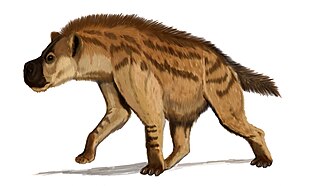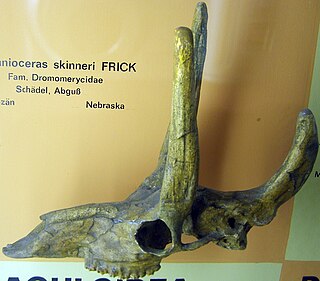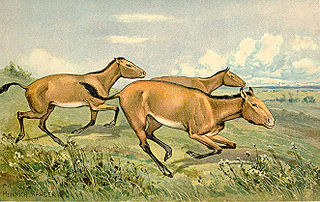
The Mustelidae are a family of carnivorous mammals, including weasels, badgers, otters, ferrets, martens, mink, and wolverines, among others. Mustelids are diverse and the largest family in the order Carnivora, suborder Caniformia. Mustelidae comprises about 56-60 species across eight subfamilies.

A pika is a small mammal, with short limbs, very round body, rounded ears, and no external tail. They resemble their close cousin the rabbit, but with shorter ears. They live in mountainous countries in Asia, and there are also two species in North America. Most pikas prefer rocky slopes. The large-eared pika of the Himalayas and nearby mountains is one of the highest living mammals; it is found at heights of more than 6,000 metres (20,000 ft). Pikas graze on a range of plants, mostly grasses, flowers and young stems. In the autumn, they pull hay, soft twigs and other stores of food into their burrows to eat during the long, cold winter. The name "pika" is used for any member of the Ochotonidae, a family within the order of lagomorphs; the latter also includes the Leporidae. One genus, Ochotona, is recognised within the family, and it includes 30 species. It is also known as the "whistling hare" due to its high-pitched alarm call when diving into its burrow. In the United States, the pika is colloquially called a "coney", a nonspecific term also used for rabbits, hares, and hyraxes. The name "pika" appears to be derived from the Tungus piika and the scientific name Ochotona is from the Mongolian word ogdoi which means pika.

Eutheria is one of two mammalian clades with extant members that diverged in the Early Cretaceous or perhaps the Late Jurassic. Except for the Virginia opossum, from North America which is a metatherian, all post-Miocene mammals indigenous to Europe, Africa, Asia, and North America north of Mexico are eutherians. Extant eutherians, their last common ancestor, and all extinct descendants of that ancestor are members of Placentalia.

The family Castoridae contains the two living species of beavers and their fossil relatives. This was once a highly diverse group of rodents, but is now restricted to a single genus, Castor.

Suidae is a family of artiodactyl mammals which are commonly called pigs, hogs or boars. In addition to numerous fossil species, 17 extant species are currently recognized, classified into between four and eight genera. The family includes the domestic pig, Sus scrofa domesticus or Sus domesticus, in addition to numerous species of wild pig, such as babirusas and warthogs. All suids, or swine, are native to the Old World, ranging from Asia to Europe and Africa.

Amphicyonidae is an extinct family of large terrestrial carnivorans belonging to the suborder Caniformia which inhabited North America, Europe, Asia, and Africa from the Middle Eocene subepoch to the Pliocene epoch 42—2.6 Mya, existing for about 39.4 million years. Amphicyonids are often colloquially referred to as "bear-dogs". They are closely related to true dogs (Canidae) and a little less related to bears (Ursidae).

Mystacinidae is a family of unusual bats, the New Zealand short-tailed bats. There is one living genus, Mystacina, with two species, one of which is believed to have become extinct in the 1960s. They are medium-sized bats, about 6 centimetres (2.4 in) in length, with grey, velvety fur.

Hyaenodontidae is a family of extinct predatory mammals, and is the type family of the extinct mammalian order Hyaenodonta. Hyaenodontids were important mammalian predators that arose during the late Paleocene and persisted well into the Miocene. They were considerably more widespread and successful than the oxyaenids, the other clade historically considered part of Creodonta.

Megistotherium is an extinct genus of hyaenodontid, the only known species of which is Megistotherium osteothlastes. It is most likely a junior synonym of Hyainailouros sulzeri.

Cimolesta is an extinct order of non-placental eutherian mammals. Cimolestans had a wide variety of body shapes, dentition and lifestyles, though the majority of them were small to medium-sized general mammals that bore superficial resemblances to rodents, weasels or opossums.

Potamotherium an extinct genus of caniform carnivoran from the Miocene epoch of France and Germany. It has been previously assigned to the mustelid family, but recent work suggests that is represents a primitive relative of pinnipeds.

Amphicyon is an extinct genus of large carnivorous bone-crushing mammals, popularly known as bear dogs, of the family Amphicyonidae, subfamily Amphicyoninae, from the Burdigalian Epoch until the late Pliocene. They ranged over North America, Europe, Asia, and Africa from 16.9—2.6 Ma ago, existing approximately 14.3 million years.

Percrocutidae is an extinct family of hyena-like feliform carnivores endemic to Asia, Africa, and Southern Europe from the Miocene through the Pliocene, existing for about 17.41 million years.

The Palaeomerycidae are an extinct family of ruminants in the order Artiodactyla, probably ancestral to deer and musk deer. Palaeomerycids lived in North America, Europe, Africa, Asia, and South America from 33 to 4.9 million years ago, existing for about 28 million years.

Dryolestoidea is an extinct clade of Mesozoic mammals that only contains two orders. It has been suggested that this group is closely related to modern therian mammals.
The European Land Mammal Mega Zones are zones in rock layers that have a specific assemblage of fossils (biozones) based on occurrences of fossil assemblages of European land mammals. These biozones cover most of the Neogene and Paleogene systems. In cases when fossils of mammals are abundant, stratigraphers and paleontologists can use these biozones as a more practical regional alternative to the stages of the official ICS geologic timescale. European Land Mammal Mega Zones are often also confusingly referred to as ages, stages, or intervals.

The Vallesian age is a period of geologic time within the Miocene used more specifically with European Land Mammal Ages. It precedes the Turolian age and follows the Astaracian age. The so-called Vallesian Crisis resulted in the extinction of several mammalian taxa characteristic of the Middle Miocene.

Monotremes are one of the three main groups of living mammals, along with placentals (Eutheria) and marsupials (Metatheria). The monotremes are typified by structural differences in their brains, jaws, digestive tract, reproductive tract, and other body parts compared to the more common mammalian types. In addition they lay eggs rather than bear live young, but, like marsupials, they store their newly hatched, larvae-like, developing puggles in a pouch, and, like all mammals, the female monotremes nurse their young with milk.
Mentoclaenodon is an extinct genus of arctocyonid ungulate mammals.
Sudamericidae is a family of gondwanathere mammals that lived during the late Cretaceous to Miocene.Its members include Lavanify and Vintana from the Cretaceous of Madagascar, Bharattherium (=Dakshina) from the Cretaceous of India, Gondwanatherium from the Cretaceous of Argentina, Sudamerica from the Paleocene of Argentina, and unnamed forms from the Eocene of Antarctica and Cretaceous of Tanzania. More recently, Patagonia, a mammal from the Colhuehuapian stage of the Miocene of southern South America, has been suggested to be a sudamericid.

















